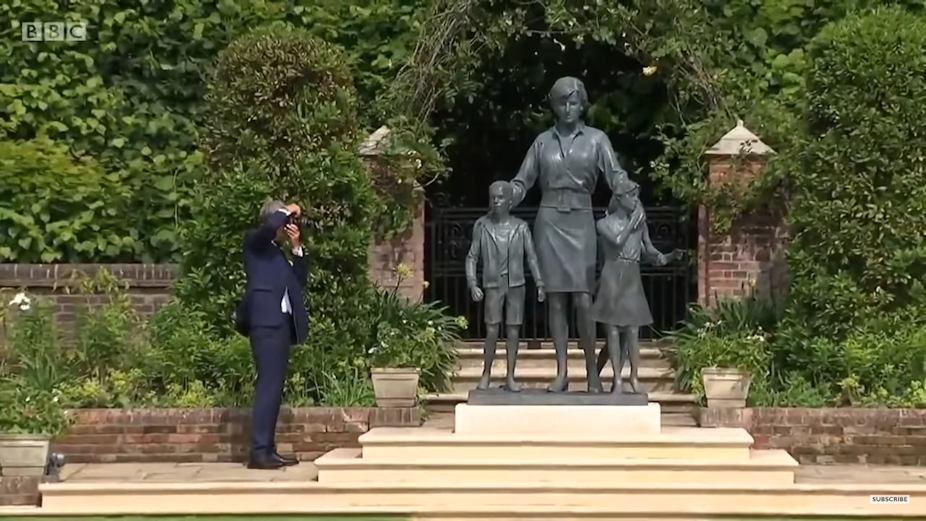The excitement around the uncloaking of a statue of Diana, Princess of Wales, at Kensington Palace on what would have been her 60th birthday seemed to spread around the world last week. But it wasn’t just the prospect of the reunion of Prince William and Prince Harry that sent the press and the public wild with anticipation.
In fact, like many tributes made in the images of the public figures we revere, it was also the appearance of the sculpture itself. Here was a memorial to a woman with one of the most recognisable faces in the world - but did it actually look like her? According to many critics, not quite. These reactions reveal the danger of sculpting a modern media star in bronze.
The sculpture of Diana with three children is by Ian Rank-Broadley. You might not know the name, but you will know his work. His 1998 profile of Queen Elizabeth II circulates on UK and Commonwealth coins. He has made relief portraits of Prince Charles and Queen Elizabeth, the Queen Mother. His medals are outstanding, and he has made several public memorial sculptures. This sort of work demands a conservatism on the sculptor’s part, and there are few British sculptors with the practised ability – or inclination, perhaps – to work in this way.
Critics have been harsh about Rank-Broadley’s sculpture. The Guardian’s Jonathan Jones, for example, writes that it was “modelled apparently with thickly gloved hands and no photo to consult”. He gets it wrong. The surface of the sculpture is uncomfortably smooth – over rather than under controlled. And there are far too many photos of Diana for any one person to contend with.
The basic problem is put in simple terms by Diana’s former private secretary: Diana “was the most photographed woman in history and everybody has their own idea of what she should look like”.
The decline of figurative sculptures
The challenge of photography to sculpture is bigger than just this example. We see so many photographs each day that their conventions shape the way we think about and see the world. To get a sense of what I mean by this, imagine a photograph of an athlete crossing the finishing line. Such an image may well impress the viewer, but it doesn’t seem strange. Take the same image into drawing, or even more so into sculpture and it looks contrived, like Han Solo frozen in carbonite.

Figurative sculpture has been in crisis for a century. From 1850, across Europe and the US, there was a mania for statues. But by around 1910 the public had already had enough. The need for memorials following the two world wars provided an unfortunate, brief stimulus but in western democracies, the very idea of a public language for sculpture was tainted by the revival of figuration in both fascist and communist dictatorships.
Consequently, sculpture followed the movement of paintings from the academy to the studio, from public conversation to private innovation. Today, there are few art schools in the UK where a student can learn how to model in clay. It’s as though this skill is no longer needed. To cap it all, our public sculptures seem to increasingly be on the wrong side of history. There is now no commonly accepted style for public figurative sculpture on which the sculptor might rely.
Read more: Edward Colston museum display: what happens next for the fallen statue
Analysing the Diana sculpture
This does not mean that the artist has free reign. The most important person is the sculptor’s subject, not the sculptor. The result for Rank-Broadley’s Diana is an impersonal and awkward smoothness. The sculptor has stepped back too far from the work. It’s an oddly airbrushed image. Compare this sculpture with Oscar Nemon’s rugged Viscount Montgomery of Alamain, or Jacob Epstein’s bust of the Italian actor Gina Lollobrigida and you will see what I mean: the hair, clothing and skin are modelled differently and with character.
The sculptor’s efforts are more apparent in the statue’s composition. Diana’s stance is protective and maternal, like a madonna. This protective pyramidal composition draws attention to its apex, which is formed by Diana’s head. The emphasis is skilfully balanced by her strong horizontal belt, which is at head height to the two children in front.
This gives the children a stronger presence, and it seems important to the meaning of the work, speaking both to the princes’ relationship with their late mother and of Diana’s interest in children. These aspects are both symbolically and sculpturally successful. Interestingly, the belt and the rest of Diana’s attire seem to come straight from the photograph shown above.
But an unfortunate consequence of this strong, protective shape is that it is so stable that it appears static. Here again, the camera works against the artist. The nation’s memory of Diana is of a mercurial, light and tragically brief life, a figure in motion. Diana was many things, but she was not stolid. What works for the sculpture is at odds with our televisual expectations.
In the laconic utterance of one art historian who preferred to remain unnamed, sculpting is “a tough gig”“.

